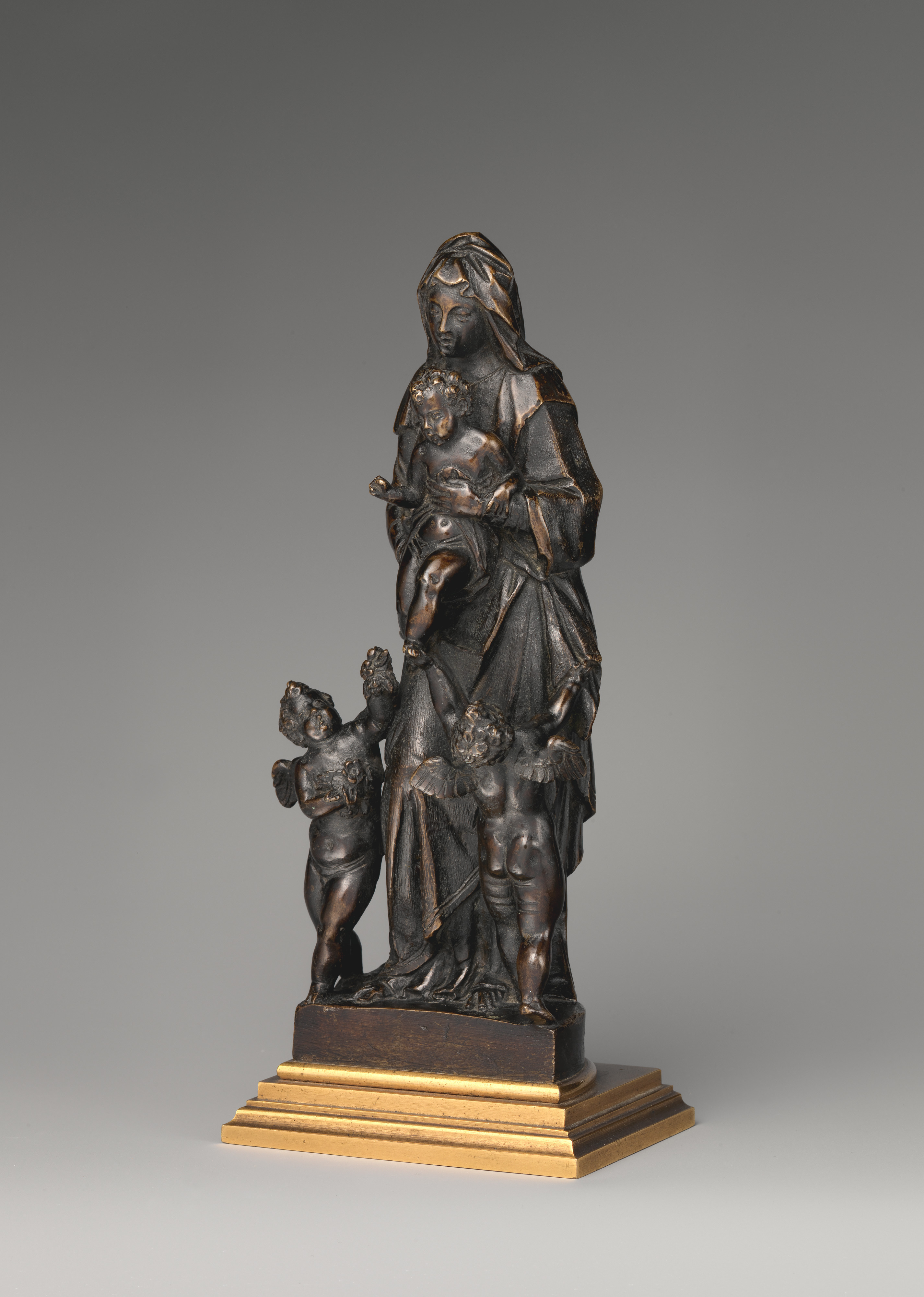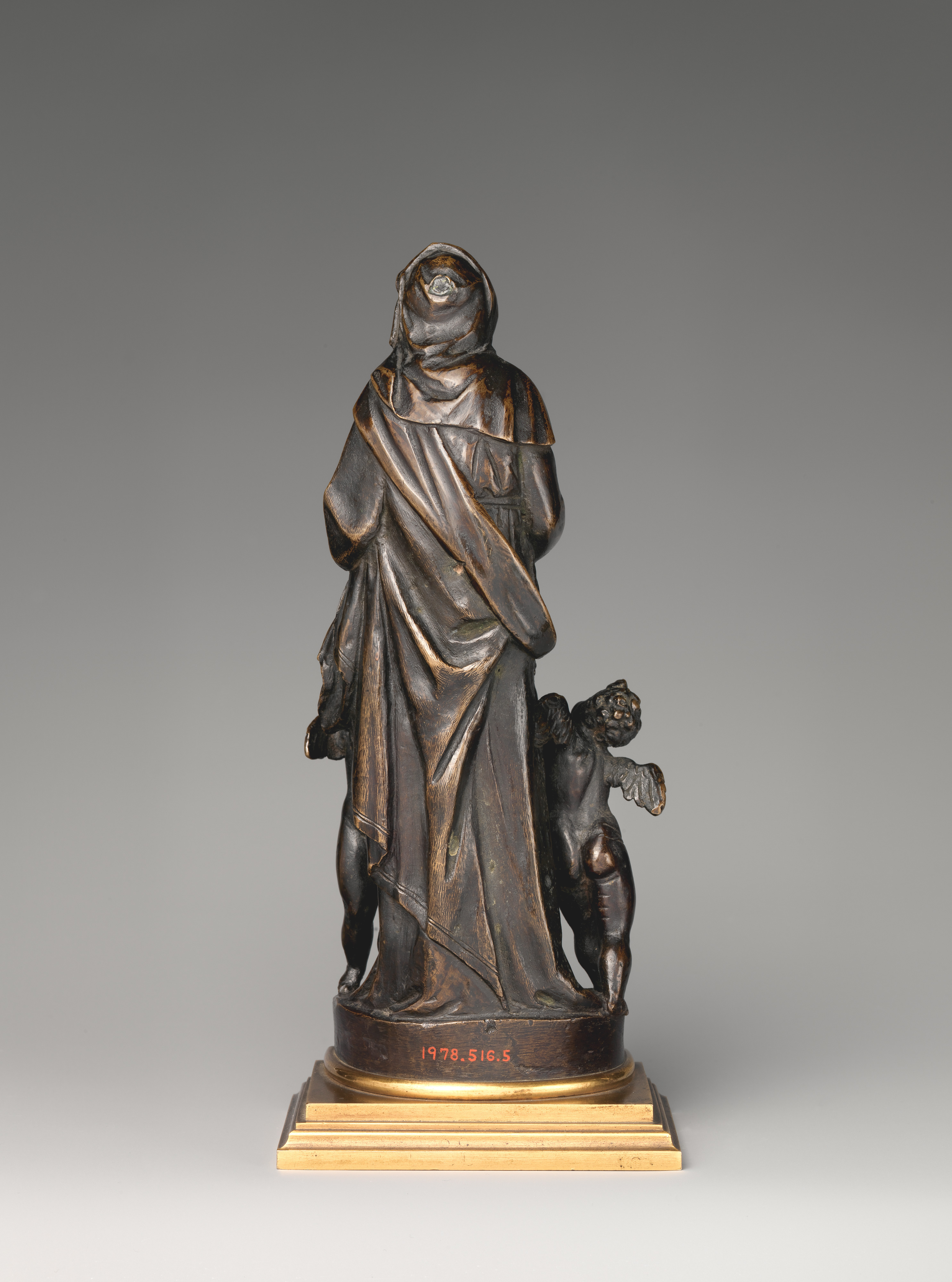Virgin and child with angels
Not on view
The small group represents the Virgin standing upright in a relaxed contrapposto, resting her weight on her left leg. She holds the Christ Child before her, supporting his bottom with her right hand and clutching him to her with her left hand at his chest. He is the size of a toddler, just like the two flanking angels. The angel to the left offers flowers to Jesus, while the one on the right has turned around so he can reach up and hold Christ’s dangling foot. The four figures form a charming and intimate composition that depicts a carefree moment rather than the weighty presentation of the Savior for veneration. This lighthearted spirit as well as the type of putti speak for an attribution to the Venetian workshop of Nicolò Roccatagliata. Also the treatment of the drapery, especially the garment that spreads out over the base with the hemline plaited in omega-shaped folds, and the feet with the overlong second toe, are characteristic elements of Roccatagliata’s style seen, although on a larger scale, in The Met’s Virgin and Child (cat. 66).
As the Madonna in the present group is very similar to a Virgin standing in the niche of a large bronze candelabrum by Roccatagliata’s son Sebastiano Nicolini, it can reasonably be attributed to him.[1] The large candelabrum is one of a pair flanking the altar of the Cappella del Rosario in Santi Giovanni e Paolo, Venice.[2] Since the sculptural decoration of this chapel is largely the work of Alessandro Vittoria, the candelabra have been assigned to him in the past. However, documents reveal the maker to be Sebastiano Nicolini, who delivered them in 1633.[3] The Scuola del Santissimo Rosario, responsible for the chapel’s decoration, specified that it wanted candelabra similar to those Roccatagliata had made in 1596 for San Giorgio Maggiore—the father’s name even four years after his death was apparently still considered to be a guarantee of quality. Although Sebastiano dutifully followed the design of his father, he introduced a new element to these candelabra, namely a sort of triangular aedicula with a scalloped niche on each side in which figures of saints and the Madonna are placed (fig. 87a). The latter is comparable to our Virgin not only in her lively expression, but also in her very similar way of holding the Christ Child, who could be a twin of the New York infant. As the figures on the candelabra measure about 18 cm, they are only slightly smaller than The Met’s Virgin, whose semicircular base suggests that she too was designed for display in a niche. However, the fact that our group is modeled perfectly all around and could thus stand free, as well as the much finer quality of the cast, point to a use within a more important context than that of a functional bronze.[4] It may have been placed in the shrine of a domestic altar from where it could also be removed if one wanted to venerate the Virgin in a more intimate way.
Sebastiano received the commission for the Rosary chapel candelabra together with a certain Andrea Balbi, a founder and one of several experts with whom he collaborated. How closely sculptor and caster worked together is evident here in the way the putto seen from behind supports the left leg of the Christ Child: what seems just an endearing detail is actually a cleverly disguised sprue, a path allowing the molten metal to move more quickly into the mold.
Sebastiano Nicolini had effectively run his father’s workshop since 1615. They specialized in the production of candelabra and small devotional art but also occasionally fashioned pagan figures for private use. The founders with whom they collaborated came from powerful clans and continued to use the shop’s models well into the seventeenth century.[5] Such products appear every now and then on the art market, but they are rarely what they are claimed to be—from the Roccatagliata workshop before 1636.[6]
Leo Planiscig published the Virgin and Child with Angels in 1930, when it was in the collection of Harry Sachs, attributing it to Girolamo Campagna. Interestingly, he placed the illustration next to a Three Graces, a small bronze group in the Galleria Estense, Modena, that he also declared to be by Campagna. The Three Graces has long since been ascribed to Roccatagliata,[7] and so it seems about time that The Met’s Virgin and Child with Angels also be reassigned to its maker, Sebastiano Nicolini, who, together with his father, must be classed among the most gifted producers of Venetian small bronzes.
-CKG
Footnotes
(For key to shortened references see bibliography in Allen, Italian Renaissance and Baroque Bronzes in The Metropolitan Museum of Art. NY: The Metropolitan Museum of Art, 2022.)
1. Sebastiano was not called Roccatagliata but Nicolini, meaning the son of Nicolino, as the father was called in the documents.
2. The chapel, devastated by a fire in 1867, was restored and reopened in 1959. Although the candelabra were damaged, they again flank the altar.
3. Kryza-Gersch 1998, p. 117.
4. The metal is a brass with low lead content, an incidental trace of tin, and low levels of the usual trace impurities, indicating the use of a high-quality copper. R. Stone/TR, November 8, 2010.
5. Kryza-Gersch 1998, pp. 120–21; Kryza-Gersch 2008, pp. 258–62.
6. It is not yet known when Sebastiano Nicolini died. He is last mentioned in 1636, when he received the commission for two statues of angels for the high altar of San Giorgio Maggiore, Venice; see Kryza-Gersch 1998, p. 115.
7. London 1961, cat. 169; Pope-Hennessy 1963b, p. 61.
Due to rights restrictions, this image cannot be enlarged, viewed at full screen, or downloaded.
This artwork is meant to be viewed from right to left. Scroll left to view more.




